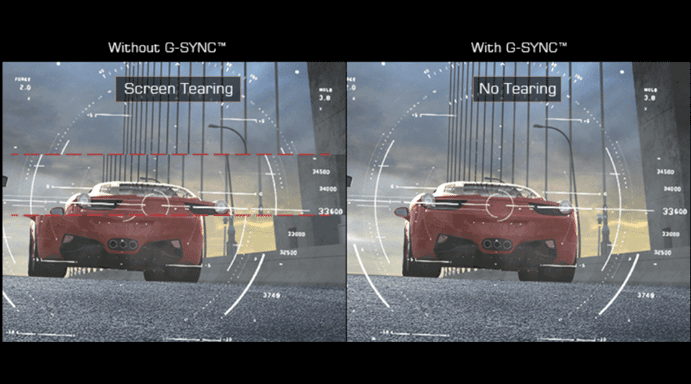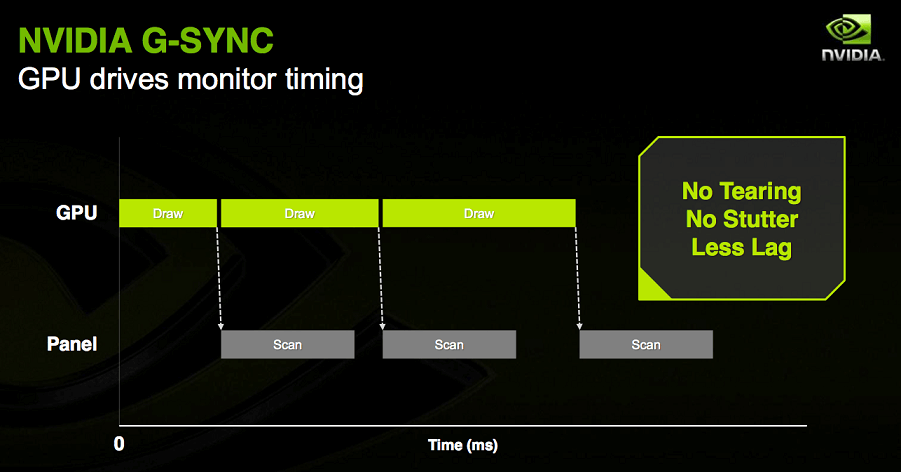Welcome! here we will answer your question – What Is G-Sync Technology?
To reduce the issue of variable refresh rates and adaptive sync, there are generally two types of advanced technology available in the market.
One is Nvidia G-Sync and the second one is AMD freesync technology.
Both the technology offers their benefits and features that help to reduce the issues of frame drops and screen tearing.
While building the PC, we need to choose those parts which are highly compatible with each other.
G-Sync is made for users who use the Nvidia graphic cards and AMD freesync technology is made for those who prefer to use AMD graphic cards.
I have written a separate article on AMD freesync technology, And in this article, we are going to focus only on the G-Sync.
Related Article: How To Enable GSync On FreeSync Monitor?
What Is G-Sync Technology?
G-Sync is the advanced version of V-Sync technology.
V-Sync was the first technology that was introduced in the monitor’s marketplace to encounter the issue of screen tearing by synchronizing the framerates of the monitor with the GPU’s output.
By doing this, you will see a great advancement in playing games and solve various issues such as frame drops and screen tearing while playing the higher refresh rates games.
There are three variants of GSync available:
- G-Sync – The standard one.
- G-Sync Ultimate – For HDR-supported content.
- G-Sync Compatible – These are basic displays that do not require Nvidia graphics to use.
G-Sync Ultimate is an advanced version of G-Sync that is available in the marketplace. It supports HDR content and displays them at ultra low latency mode and can run the games at the highest refresh rates at maximum resolutions.
Meanwhile, I have written one complete article on the best 1440p 144hz monitors. You can check them. These monitors are the best choice for gamers and come with minimum input lag.

Setup Required To Run Then NVIDIA S-Sync
Here is the basic setup you need to require to use the Nvidia G-Sync or G-Sync Ultimate.
- Windows 8 or higher
- GTX 650 Ti graphics card or higher
- DisplayPort 1.2
- Driver R340.52 or higher
Pros And Cons
Pros: Like FreeSync, G-Sync caps the variable frame rates that are coming from the GPU and matches the refresh rate of the monitor.
This will eliminate the screen tearing and input lag of the computer at the peak performance of the monitor.
Suppose, your monitor has a 60hz refresh rate and your GPU rendering 100 frames per second then it will create trouble and you will get screen ghosting issues.

Cons: G-Sync only works with NVIDIA devices and it does not support AMD graphic cards.
Apart from this, G-Sync is a luxury and it is always considered as expensive technology as compared to AMD FreeSync.
But now, NVIDIA released their Nvidia g sync driver that enables the GPU to work with certain more monitors and FreeSync supported monitors as well.
G-Sync Supported Connection
There are some differences between the connection type of G-Sync and Freesync.
FreeSync supports HDMI and DisplayPort connections and it also supports USB type C connections. You can check out the list of monitors that comes with a USB type C port here.
Whereas G-Sync only supports DisplayPort.
FAQ’s
What is G-Sync and do I need it?
G-Sync is an advanced display technology developed by Nvidia that synchronizes the variable refresh rate of your monitor with the frame rate outputted by your graphics card. By doing so, it eliminates screen tearing and reduces input lag, resulting in a significantly smoother and more immersive gaming experience. Whether you need G-Sync depends on your personal preferences and gaming setup, but it is highly recommended for gamers who value visual quality and fluid gameplay.
What’s better: G-Sync or FreeSync?
The choice between G-Sync and FreeSync depends on several factors, including your gaming setup and preferences. G-Sync is compatible only with Nvidia graphics cards and tends to be more expensive. On the other hand, FreeSync works with both AMD and Nvidia graphics cards and is generally more affordable. However, G-Sync often offers slightly better performance in terms of minimizing screen tearing and input lag. Ultimately, the decision between the two technologies should be based on your specific needs and budget.
Is G-Sync only for GTX?
Initially, G-Sync was limited to Nvidia’s GTX graphics cards. However, the technology has evolved, and now G-Sync is compatible with newer GTX and RTX graphics cards. This broader compatibility allows more users to benefit from the advantages of G-Sync across a wider range of Nvidia GPUs.
Does G-Sync use HDMI or DisplayPort?
G-Sync technology can be utilized with either HDMI or DisplayPort connections. However, for optimal performance, it is recommended to use DisplayPort as it offers better bandwidth capabilities and support for a higher refresh rate. This ensures a smoother gaming experience with G-Sync active.
Can you use G-Sync on any monitor?
No, not all monitors are compatible with G-Sync. To use G-Sync, your monitor must either be certified by Nvidia as “G-Sync Compatible” or have a built-in G-Sync module. Nvidia provides a list of G-Sync Compatible displays on its website, which you can refer to when choosing a g sync monitor. It’s important to ensure that your monitor supports G-Sync for it to function properly.
How do I know if my monitor is using G-Sync?
To determine if your monitor is using G-Sync, there are a few indicators you can look for. Firstly, you may see the G-Sync logo displayed on your monitor’s on-screen menu or within your graphics card control panel. Additionally, you can check the refresh rate settings in your graphics card control panel to verify if G-Sync is enabled. If your monitor is indeed utilizing G-Sync, you can expect a smoother and tear-free gaming experience.
Conclusion
GSync improves your gaming experience and will help you to fix various screen-related issues.
Depending on your budget, you can choose which technology you should prefer, which is FreeSync or GSync. Both are the leading technology right now and have tough competition between them.
This technology is best for those who hate the screen tearing issue or for those who want to run their high-end games very smoothly and hardcore fans of higher refresh rates.
Visit us at TheBestMonitors.com for more great monitors information!
